It’s undeniable: Fur is back. At New York Fashion Week last month, this extravagant, expensive material was so abundant, it might have been everyday wool. Not just seen on coats, jackets, and stoles, designers fashioned furs into skirts, oversize mittens, dresses, blouses, and even hoodies. Most of the top designers, including Ralph Lauren, Calvin Klein, and Marc Jacobs, showed real fur in some form on the runway.
“People as a whole are never going to stop liking fur.”
In fact, it’s not unlike the 1930s, when Americans weathered the Great Depression, followed by the wartime-rationing of the 1940s. “The movies were about luxury, luxury, luxury,” says Samantha Davis of the New York City-based web retailer Sammy Davis Vintage.
“People would go into the cinema, and live in that scene. They’d get to feel like they were one of those wealthy people for a few hours, then go back home to their normal lives. The same can be said for fashion. You can see it as a voyeuristic experience.”
But this trend is causing dismay among animal-rights activists, who’ve spent the past three decades campaigning against the use of fur in fashion.
“Fur is one of the most egregiously cruel industries out there,” says Christy Griffin, special projects officer for In Defense of Animals, based in San Rafael, California. “Every year, over 50 million animals, including dogs and cats, are killed for their fur worldwide. Eighty-five percent of animals killed in the fur industry come from fur farms—dismal places where foxes, rabbits, minks, chinchilla, and other animals spend their entire short lives in these tiny, filthy metal cages. Then, they’re killed in really horrific ways, such as bludgeoning, neck-breaking, or electrocution.”
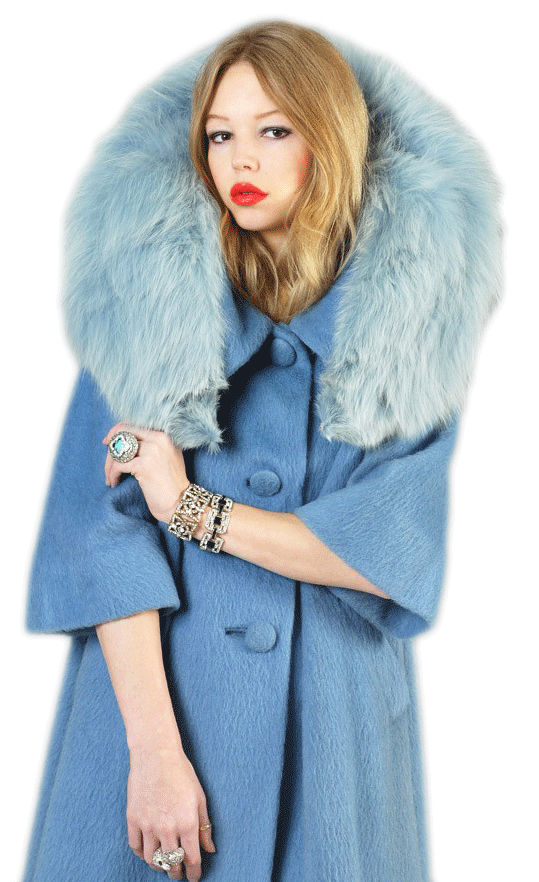
Top: Carrie Bradshaw, played by Sarah Jessica Parker, wore a vintage raccoon fur coat, in the first season of “Sex and the City.” Above: Bustown Modern’s inventory includes this rare 1950s Lilli Ann trapeze coat with shaggy wool and a fox collar dyed powder blue. (Courtesy of Bustown Modern)
For fashionistas who love both animals and wearing fur, going vintage seems like a simple solution. Old furs don’t directly contribute to the profits of modern fur farms, and they’re less toxic to the environment than faux furs (shown by Anna Sui and Christian Siriano on the runway), which are made from petroleum. Fur coats and stoles from the ’50s and ’60s evoke the lux, decadent glamour of Marilyn Monroe and Elizabeth Taylor, but vintage furs go for a fraction of the cost of their contemporary counterparts.
“Some coats I have are from the ’20s, so the animal has been gone for a very long time.”
But according to Griffin, vintage fur is actually to blame for the renewed appetite for fur fashions. In the 1980s, groups like IDA, People for the Ethical Treatment of Animals, and the Animal Liberation Front started drawing attention to the brutal reality of fur farming. By the late 1990s, their sometimes-controversial campaigns, featuring celebrities like Pamela Anderson and Alicia Silverstone, succeeded in creating public distaste for furs, so that they no longer appeared on fashion runways.
Then, in 1998, HBO introduced its iconic single-girl show, “Sex and the City,” spotlighting a fashion-obsessed sex columnist, Carrie Bradshaw, strolling around New York City in a vintage fur coat. Griffin says that Vogue editor-in-chief Anna Wintour credits Carrie Bradshaw with bringing fur, old and new, back into fashion.

A black silk jersey stole trimmed with white fox fur sold for $49,946, along with this photo of Marilyn wearing the stole, at a December 2008 auction in London. (Christie’s Images Ltd.)
But vintage dealers like Davis and Elizabeth Hine, of Hinesite Vintage in Lancaster, Pennsylvania, say certain women never stopped loving their furs—and nothing is going to change that.
“If you go to any city, like New York, or other places where it’s cold—people wear fur,” Hine says. “I would rather see somebody with a vintage coat on because it’s already made. Some of the coats I have are from the ’20s, so the animal has been gone for a very long time. At least they’re preserved in a coat.”
Davis, who just published on an e-book called The 100 Best Vintage Shops Online, says that vintage clothing in general is greener than the modern fashion industry, and that she would prefer if furriers repurposed old furs rather than kill living animals. One new fur coat, for example, uses as many as 55 minks, 100 chinchillas, or 125 ermines, according to IDA.

A silver mosaic chinchilla, a rodent native to the Andes Mountains is becoming rare, because of the popularity of its thick, velvety fur. (Photo by Kjersti Holmang)
“Do we need to produce billions of new garments a year? No,” she says. “Wearing second-hand fur is so much less detrimental to the environment than buying a new wool jacket is. I would much rather wear my grandmother’s fur coat that’s lasted since the ’50s than go buy something from J. Crew that I’m going to wear for two years and dispose of.”
In fact, Davis has had Facebook fans “Unlike” her page over pictures of her wearing vintage fur. She says she respects that people have strong opinions about fur, but she wishes they would suggest alternative uses for vintage fur, instead of simply getting angry.
“When it comes to wearing it, I understand that it perpetuates the trend as a whole, so it’s a risk when you walk around in it, because people can’t tell whether you’re in vintage or not,” she says. “But we’re always going to come across fur, whether it’s in our grandmother’s closet or at Goodwill.”
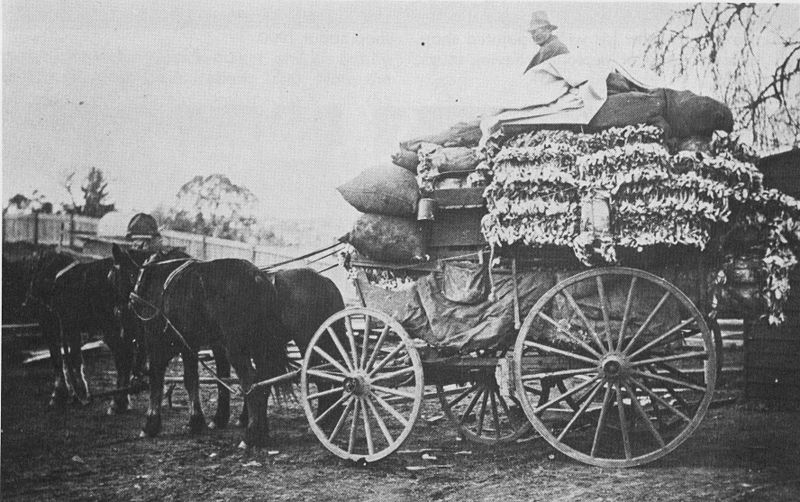
Bert Mann with a load of rabbit skins, Walcha, New South Wales, circa 1905. (Gooreen collection)
Rachel Poliquin, the author of The Breathless Zoo: Taxidermy and the Cultures of Longing, says she’s always wondered why the fur fashion has always garnered so much more hatred than other uses of animals like eating meat or making leather clothes, bags, belts, or shoes.
“I can’t help but think about the fact that it’s a luxury item,” she says. “Why are furs considered to be so much more offensive and horrible than eating a steak? In my mind, it’s the same thing. An animal died in both cases. But one, I guess, has got a little more glamour to it. It’s got the Marilyn Monroe aspect.
“As soon as you get into talking about animals, and the appropriate ways we use animals, it’s just such a never-ending pit of questions,” Poliquin continues. “Unless you live your life without using any animal products, and you don’t wear leather shoes or a leather belt, and you don’t eat meat, you’re always a hypocrite, and there is no gray. I think a lot of people like to live in the gray zone.”

Australian singer Natalie Imbruglia, known for her 1998 single “Torn,” posed for an anti-fur ad for People for the Ethical Treatment of Animals in 2008.
Griffin’s organization, of course, encourages people to give up meat-eating and leather-wearing altogether. She says IDA is concerned about the well-being of cows—which provide both beef and cowhide—horses, and sheep, as well as the less cuddly cold-blooded animals like snakes, alligators, and crocodiles used for purses, belts, and shoes.
“Not all leather comes from the meat industry, which is a common misconception,” Griffin says. “A lot of leather is brought into the United States from other countries such as India where they don’t even eat cows.”
That’s exactly the point of buying vintage fur and leather, vintage dealers say. You aren’t buying any new cheap animal products from Asia, which is so far removed from the United States, you’ll never know how the animals are used or treated. And vintage fur can give you that Old Hollywood luxury, while saving you thousands of dollars.
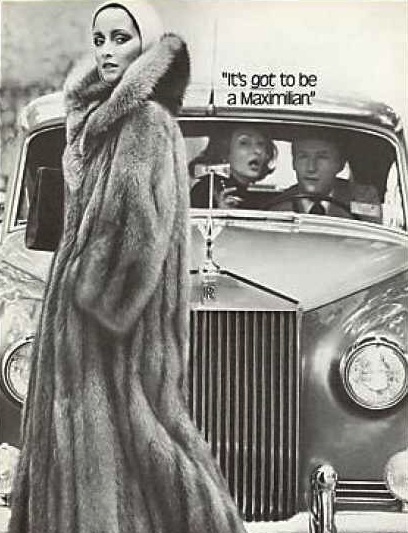
A Maximilian Fur Coat advertisement featuring an envious couple in a Rolls Royce in 1976. (Via VintageAdBrowser.com)
“Buying fur is like buying a car,” says Anessa Woods, who runs the Columbus, Ohio-based online vintage retail shop Bustown Modern. “There’s absolutely no reason to buy a new car or a new fur because the minute you drive it off the showroom floor or wear it out of the store, you lose 50 percent of the value. If you spend $100,000 on a brand new sable coat, you’re going to be lucky if you can sell it for $15,000 two years later.
“That’s why I love selling used fur, because people can get something fantastic and get a good deal on it,” she continues. “People say, ‘Oh, gosh your stuff goes for such high prices!’ This Christian Dior full-length fox fur coat was probably $25,000 when it was brand new, and if you’re getting it for $3,500, you’re getting a steal.”
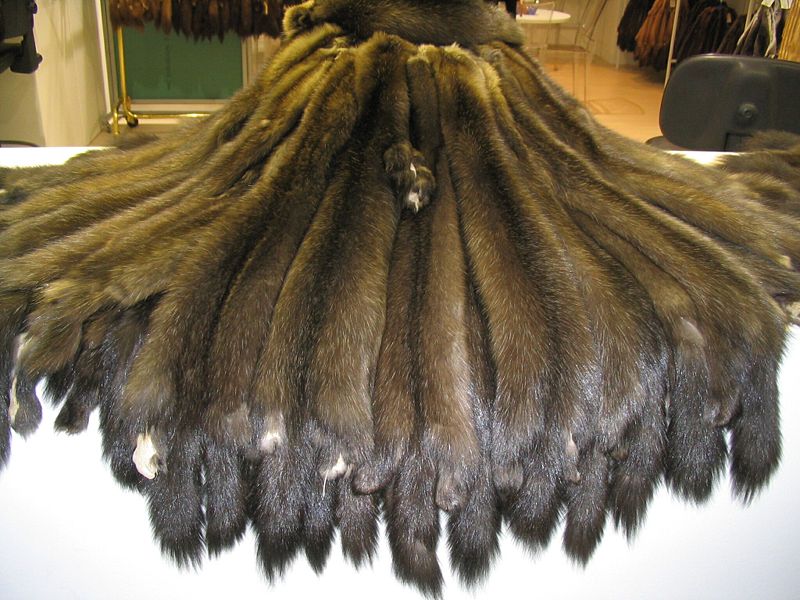
Barguzinsky sable fur-skins in Milan, Italy. The price corresponds with the upper coat’s glossiness and blackness.
A more practical reason furs were coveted in the 1950s and ’60s, Davis says, is that cars didn’t have heat. So people would wear the warmest coat possible while driving, known as “car coats.” Griffin says that today we have innovative materials like down-filled jackets that are better at keeping you warm, but Woods disagrees.
“I can’t lie; there’s nothing warmer than fur,” she says. “I have coats that are down filled, and I don’t necessarily feel as warm and protected as I do in a fur.”
Back in the caveman days, clearly warmth was the biggest motivating factor for wearing furs. But in the Middle Ages, certain furs became symbolic of monarchies. Picture a red, fur-trimmed royal robe or crown from a storybook: Do you see white fur with black spots? That’s fur from ermine, also known as stoat, and, in countries such as England, sumptuary law decreed only royalty could wear it. In Russia, the same held true for sable, the fur of tsars.

Elizabeth I of England was painted with a heraldic ermine, which has black spots over its entire body. (Courtesy of the Hatfield House)
Being a fur fit for a king wasn’t what brought the Eurasian beaver to the brink of extinction, though, it was haberdashery. According to Poliquin, who is working on a book on the history of the beaver industry, in the mid-1600s, Europeans discovered that beaver fur felted into the best wool for hats. In the 1700s, everything from top hats to Napoleon’s bicorne to the Pilgrim’s cockel hats were made of beaver felt. The shortage of beavers on the continent soon meant the North American beaver trade with Native Americans in Canada became extremely important.
“When they felted the wool underneath the longer guard hairs, it was waterproof,” Poliquin says. “When you wanted a broad brim, beaver felt held its shape very well in the rain, compared with some other materials, which would wobble all around. Everyone fell in love with it. Then in the 19th century, silk came to replace beaver, and then the beaver trade fell apart. And I’m sure the beaver was very thankful.”

Shapes and styles of beaver hat 1776-1825, from the 1892 book “Castorologia, Or, The History and Traditions of the Canadian Beaver,” by Horace T. Martin.
The difference in how people view fur may also have something to do with how much nature is a part of their day-to-day lives, Poliquin explains.
“My dad grew up in Saskatchewan, which is very cold in the 1940s, and when he was young, people had buffalo furs,” she says. “It wasn’t a luxury item. My dad’s family lived way out in the country, they often trapped animals, and they used their furs in a very close relationship with the landscape. I can see that an increasingly urban population would prefer not be reminded: This is not just a beautiful piece of fabric; somebody died to give it to me.”
Many fur stoles and coats from the 1920s and ’30s feature the animal’s heads, feet, or tails—and this trend, which we might find shocking today, didn’t fully fade until the mid-1950s.

This vintage fox scarf is made of four foxes, with at least two faces, eight feet, and four tails of the animals.
“More and more people don’t want to be associated with the cruelty that’s inherent in the industry, and the fact that they are dead animals,” Griffin says. “In the ’20s, it was a little more socially acceptable to be parading around with the full bodies of animals. These days, people want to be less associated with the cruelty, which is why you see the shaved furs and the multi-colored furs now.”
“As strange as it is today, it was indicative of glamour,” Davis says. “You would throw that double fox-head shawl over your 1930s slip dress, walk onto the red carpet, and call yourself Rita Hayworth.”

This 1970s silver dyed fox tail gilet is one of Anessa Woods’ finds, which Bustown Modern is selling. (Courtesy of Bustown Modern)
But without those obvious, identifying features, it becomes easier to mislead buyers about what animal the fur came from. For example, “poor man’s mink” has long been a code word for muskrat or opossum furs, which have much wider pelts than actual mink, Hine says. Coats labeled as chinchilla are often made from chinchilla rex rabbits, bunnies bred to have fluffy, feathery fur like chinchilla, Woods explains. These days nutria, which are similar to guinea pigs, are bred to have fur as soft as mink.
“Generally, I can just touch it without seeing it and know what kind of fur it is,” Woods says. “But there are a lot of people who have trouble distinguishing between a stone marten, a sable, a mink, or a fisher fur. It confuses me sometimes, too.”
While mink and sable are among the most expensive and desirable furs, rabbit fur has always been on the low end. Clearly, there’s a reason people joke about “breeding like rabbits.” Thanks to the abundance of rabbit, Wood explains, it would often be used as a starter fur for girls and teenagers in the mid-century. Other young girls would be gifted faux furs before they got their first real fur.

Elsa Schiaparelli’s hat made from a leopard’s face was featured in the September 1939 issue of Bazaar. (Via DevorahMacdonald.blogspot.com)
For adults, some of the most coveted furs came from “exotic” animals like leopard, which was used by surreal fashion designer Elsa Schiaparelli starting with her 1939 collection. In 1961, Oleg Cassini designed an elegant leopard fur-coat for First Lady Jacqueline Kennedy, and suddenly, every woman just had to have a leopard coat—pushing the big cat toward extinction, as more than 250,000 were killed for furs.
Cassini quickly became an adamant animal-rights activist. “After that I decided to never use (real) furs in my designs again,” he’s quoted as saying. “There’s no logic in real fur; it was a different time, when people didn’t have choices. Now it’s just a luxury item.”

A Revlon ad from 1965. Women went wild for leopard after Jackie Kennedy wore a leopard-fur coat in 1961. (Photo by John Rawlings)
These days, vintage dealers have to be especially careful to mind the Endangered Species Act of 1973, which bans the trade of any product from one of the 2,000 animals on the endangered species list. Anyone in the United States who sells leopard, ocelot, margay, tiger, cheetah, bear, or otter may face fines up to $100,000 and possibly jail time. Most big cats—even bobcat and Canadian lynx in certain states—are considered endangered.
The tricky piece is recognizing furs made from weasel-like spotted civets, which are not endangered and were used to make furs imitating leopard or jaguar, Woods says. These days, you have to be especially careful you can verify what you have is civet. Spotted furs from Asia, for example, could also be made from house cats.

An illustration of an African civet—valued for both its fur and its musk—created by English naturalist Richard Lydekker in 1894.
Even if you know you’ve found a legitimate, legal vintage piece, the condition of an old fur will never compare to that of a new fur. Woods says that fur farms have practiced animal husbandry for so long now that they sell the plushest, silkiest furs imaginable today.
“A fox from the 1920s oftentimes is very coarse, and it can be a bit dried out, because it’s nearly a hundred years old, especially if it’s not well cared for,” Woods says. “Fur now is a lot sleeker, longer, thicker, and plusher. I’ve never picked up a fur from the 1920s and been like, ‘Wow, this is the most perfect, gorgeous, sleekest, silkiest, shiniest fur I’ve ever felt.’ But that doesn’t mean that it isn’t a good example of a high-quality fur from that time.
“Fur isn’t just for dressing up anymore. I wear it to the grocery store.”
“Even looking at a mink fur from the 1950s to now is completely different,” she continues. “Now, when you drop a mink fur on the floor, it just literally puddles almost like water, like silk. Older minks, even if they’re soft, supple, lovely, and still in luxurious condition, having been kept in cold storage, the fur is a little bit coarser.”
Like anything organic, old furs can shed and rot, which is why, according to Griffin, the production of new fur is as toxic to the environment as faux fur: New fur is loaded with chemicals that prevent decay. “Shedding is a sign of dry rotting so you really want to be careful of that,” Woods says. “After time, most furs will shed a little bit, but once you brush it once or twice that should pretty much stop.”

A glamorous ad for Saga Furs was featured in the September 1955 issue of Vogue. (Via Adored-Vintage.blogspot.com)
Hine agrees that you’ll never find furs from certain eras in perfect condition anymore, but that doesn’t mean a rare fur isn’t worth it.
“To be considered in good condition, it has to be supple,” she says. “It shouldn’t feel stiff at all. Most furs have what are known as guard hairs on them, and then there’s another layer of fur. If you pull on the guard hairs and you get a handful of them you know it’s got some age to it, and you’re going to be losing fur. Then it just depends on how much you like that fur.”
Vintage furs in the best condition have been kept in cold storage, Hine says. Like paper or fabric, furs are susceptible to moisture, but also suffer when kept in plastic bags.
“Furs have to be stored properly, or they lose their integrity,” Hine says. “If you buy fur that’s been stored in plastic, it feels different. The plastic makes fur deteriorate, it gets a little stiff, and the guard hairs will come out. It depends on how long it’s been stored in plastic and also, where in the house it was stored, whether in the closet or in the basement. If you want, put it in a pillowcase, something that can breathe. It’s not always best to store it on a hanger, even.”

An ermine, or stoat, in its winter coat. (Photo by Steven Hint)
And, if you’re going to wear a vintage fur, she says, don’t ever carry a shoulder bag or backpack.
“Why are furs considered to be so much more offensive and horrible than eating a steak?”
“When you buy something vintage, you can’t treat it like something brand new,” Hine says. “If you have to wear a shoulder bag, it’s best to wear it cross body, but it’s best not to carry shoulder bags at all with vintage fur. That’s where most of the stress on the fur would be just from hanging for years, on the shoulders and the back of the neck. If it’s going to dry out, that’s where it will.”
Generally, the most desirable vintage furs come the late 1940s up until the 1980s. Great Lakes Mink Association (GLMA), formed in 1941, trademarks its dark minks as Blackglama, while the Mutation Mink Breeders Association (EMBA), founded in 1942, branded its minks as The American Mink and trademarked its fur colors such as Desert Gold (light brown), Argenta (grey), Cerulean (blue), Azurene (pale grey), Jasmine (white), Tourmaline (pale beige), and Diadem (pale brown).

This 1960 ad for EMBA, or the Mutation Mink Breeders Association, boasts about its natural Cerulean blue fur. (Via Found in Mom’s Basement)
Since the late 1960s, Blackglama has employed big-name celebrities for its ongoing “What Becomes a Legend Most?” ad campaign, including Bette Davis, Judy Garland, Lena Horne, Brigitte Bardot, Rita Hayworth, Liza Minnelli, Ray Charles, Rudolf Nureyev, Cher, and Audrey Hepburn. In 1986, GLMA and EMBA merged to form American Legend Cooperative, still using the Blackglama trademark and advertising.
Throughout the decades, top New York and Parisian fashion houses, including James Galanos, Pierre Cardin, Nina Ricci, and Christian Dior, have all hired top furriers to produce their designs from mink, fox, and other animals. The French fur company Révillon Frères, supplied the furs for Saks Fifth Avenue between 1970 and 1995. As a result, vintage fur now can be found in every style imaginable.

Blackgama’s ongoing “What Becomes a Legend?” advertising campaign, started in 1968, features celebrities like Cher and opera singer Jessye Norman in the brand’s dark mink.
“As long as you get a good fit, you’re pretty much good to go,” Woods says. “A lot of people will say, ‘I want this to be short and tight.’ But fur is so delicate, you want it to be looser, and you don’t want to be constricted in your movement because you’ll tear it. It’s delicate. It’s this really thin, little skin.”
These days, fur is worn with anything, for pretty much any activity. For a casual look, Woods recommends a hip-length short swing coat or a knee-length stroller.
“You can pair a stroller coat with jeans, you can put it over a dress, you can put it over a business suit,” she says. “There’s a million ways to wear it. So many fashion walls have been knocked down over the years, and fur isn’t just for dressing up anymore. It’s for doing everything in. It’s your everyday life. I wear it to the grocery store. But then I work from home a hundred hours a week, so going to the grocery store for me is a really good time out.”

Bustown Modern just sold this cropped jacket, made of arctic fox fur. (Courtesy of Bustown Modern)
But if you come across a vintage fur in your attic, or inherited a fur from your grandmother that you feel compelled to dispose of, you have several options. On her blog, Samantha Davis details several ways to recycle furs, including programs that give used furs to homeless people in cold climates, turn furs into teddy bears for mothers staying at shelters, and use furs for education and period re-creation.
“In the ’20s, it was more acceptable to parade around wearing the full bodies of dead animals.”
The Coats for Cubs program, started by the Humane Society of the United States and run by Buffalo Exchange, takes furs every winter, starting mid-January and running until Earth Day, April 22. These old furs are fashioned into beds for orphaned wildlife, who associate the texture with their lost mothers. “For orphaned wildlife, they’ve found that the donated furs are particularly effective in lending comfort and giving the feel of a missing maternal figure,” Griffin says.
Griffin says people can send their furs to In Defense of Animals, too. “We have a fur amnesty program, where people can send in their unwanted furs for a tax deduction,” Griffin says. “I actually use those in educational displays, protests, as well as donating them to wildlife rehabilitators. The only way you can prevent that suffering is to not buy or wear fur of any kind. And that’s vintage full-length coats or even gloves with fur trim.”
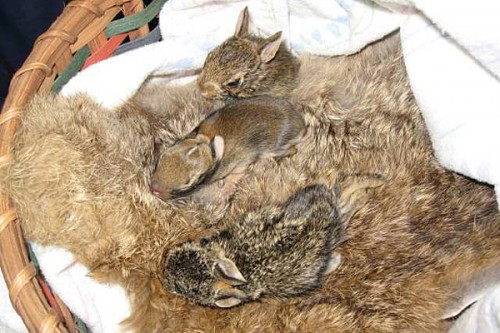
Orphaned baby rabbits get cozy on a recycled rabbit fur, thanks to Coats for Cubs. (Via SammyDVintage.com)
Davis, however, believes that vintage fur is essential for solving the problem.
“There are always going to be those who really dislike fur, and then there’s always going to be those in the middle, and then those who really like it,” Davis says. “So how can we get those in the middle and those who really like fur to buy second-hand? How can we change the new fur industry in such a way that they are producing less or turning to second-hand fur to recycle into new looks? If that can become part of the public consciousness, then we can alleviate the problem, because people as a whole are never going to stop liking fur.”
To learn more about identifying vintage fur, see Davis’ post “How to Identify Vintage Mink, Fox, Rabbit, Beaver & Raccoon Furs,” as well as the Vintage Fashion Guild’s Fur Resource. If you are interested in recycling your vintage fur, check out Davis’ article “How to Recycle Vintage Fur.”

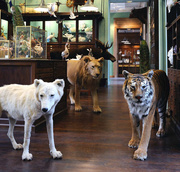
 Hidden Gems: Lost Hollywood Jewelry Trove Uncovered in Burbank Warehouse
Hidden Gems: Lost Hollywood Jewelry Trove Uncovered in Burbank Warehouse
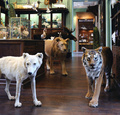 Taxidermy Comes Alive! On the Web, the Silver Screen, and in Your Living Room
Taxidermy Comes Alive! On the Web, the Silver Screen, and in Your Living Room Hidden Gems: Lost Hollywood Jewelry Trove Uncovered in Burbank Warehouse
Hidden Gems: Lost Hollywood Jewelry Trove Uncovered in Burbank Warehouse Va-Va-Voom Vintage: Dita Von Teese on Burlesque, Cars, and Lingerie
Va-Va-Voom Vintage: Dita Von Teese on Burlesque, Cars, and Lingerie Fur CoatsNothing telegraphs decadent, luxurious glamour like fur. During the Golden …
Fur CoatsNothing telegraphs decadent, luxurious glamour like fur. During the Golden …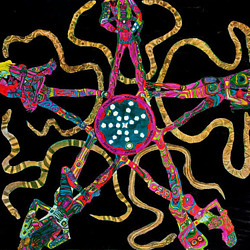 Mari Tepper: Laying it on the Line
Mari Tepper: Laying it on the Line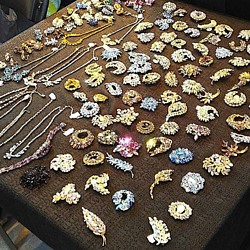 Nice Ice: Valerie Hammond on the Genteel Charm of Vintage Canadian Costume Jewelry
Nice Ice: Valerie Hammond on the Genteel Charm of Vintage Canadian Costume Jewelry How Jim Heimann Got Crazy for California Architecture
How Jim Heimann Got Crazy for California Architecture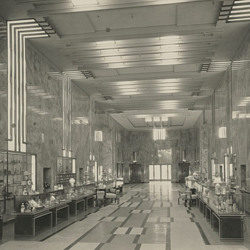 Modernist Man: Jock Peters May Be the Most Influential Architect You've Never Heard Of
Modernist Man: Jock Peters May Be the Most Influential Architect You've Never Heard Of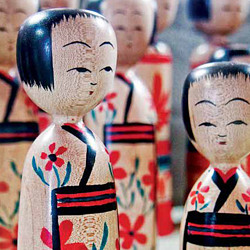 Meet Cute: Were Kokeshi Dolls the Models for Hello Kitty, Pokemon, and Be@rbrick?
Meet Cute: Were Kokeshi Dolls the Models for Hello Kitty, Pokemon, and Be@rbrick?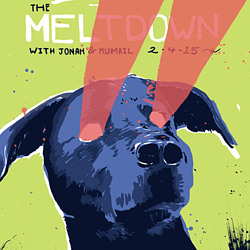 When the King of Comedy Posters Set His Surreal Sights on the World of Rock 'n' Roll
When the King of Comedy Posters Set His Surreal Sights on the World of Rock 'n' Roll How One Artist Makes New Art From Old Coloring Books and Found Photos
How One Artist Makes New Art From Old Coloring Books and Found Photos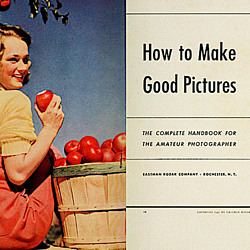 Say Cheese! How Bad Photography Has Changed Our Definition of Good Pictures
Say Cheese! How Bad Photography Has Changed Our Definition of Good Pictures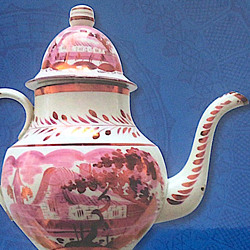 Middle Earthenware: One Family's Quest to Reclaim Its Place in British Pottery History
Middle Earthenware: One Family's Quest to Reclaim Its Place in British Pottery History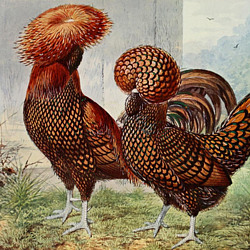 Fancy Fowl: How an Evil Sea Captain and a Beloved Queen Made the World Crave KFC
Fancy Fowl: How an Evil Sea Captain and a Beloved Queen Made the World Crave KFC
I love vintage fur and wear it proudly….can’t please everyone, so I please myself.
Thank you for including the other side of the vintage fur debate in your article, Lisa. I want to reiterate that in addition to the horrific cruelty to animals on fur farms and wildlife caught in traps, there is no such thing as “green” or “eco-friendly” fur. It takes more than 15 times as much energy to produce a fur coat than it does to produce a fake fur. Furs are loaded with chemicals to keep them from decomposing, and fur production pollutes the environment, wastes precious resources and poisons our waterways. Please visit idausa.org for more information.
I don’t feel bad wearing my fox stole, but it’s from the 40’s, before my Mum was even alive. But I do make sure to be careful where I wear it, as some people do give me odd looks. And when it finally is time to stop wearing it, I’ll just buy another vintage.
I have had this struggle first hand. My grandmother was a runway model during the depression, occasionally instead of paying the models, they gave them the clothes they were modeling. My grandmother had lots of furs, she loved them and considered them a source of pride and had felt that she worked for them. She was stricken with Alzheimer’s when I was 14 and when she moved in with us, I became her primary caretaker. When she died, she left all of her fur coats to me – the vegetarian. I tried to think of ways to donate the coats or recycle them in some creative way, but I couldn’t bring myself to take them apart. They meant so much to her and so on very special occasions I wear them out in the world. I tell people they belonged to my grandmother and they were important to her and so I am honoring her even though I would never buy a fur coat for myself. I would hope the current fur industry leans towards fake fur. In the mean time, Once a year I will wear my grandmothers 1920’s Persian lamb opera cape with the mink collar and honor her.
Beverly Johnson, dearie, there’s a saying that fits perfectly with your statement. Fur is worn by beautiful animals and ugly people. And yes, that means inside. I actually find despicable for a human being to lower so much in taking pleasure wearing something that animals were killed for. It’s a pathetic way of pleasing yourself.
If it is vintage, then there is nothing you can be blamed for and you can wear it. It was a different time that it used to be worn in so vintage fur isn’t a problem for me, If it’s new fur, then no
I have no problem with folks wearing fur (although, as a guy, I don’t). It’s no different than wearing leather (which I do). As far as the rabbit lady ad…if I was going to kin a rabbit for its fur, I’m going to eat its grilled flesh afterwards.
I like that your article encourages people to wear fur because there is absolutely nothing wrong with it, and your article is very well researched and written. But I really wish people would question the ‘evidence’ that is presented to us of the cruelty of fur farming. Has nobody else noticed that they are recycling the same video of animals being skinned alive? I for one will not make my decision around fur based on a video… I would like to see what goes on with my own eyes before making this judgement. But electrocution, skinning alive and bludgeoning to death? Does this really sound plausible to you?
Fur is fur. It’s outmoded. Trying to give vintage fur a pass is like arguing that eating bacon is OK because the pig was going to die anyway. Or arguing that you shouldn’t send food back at restaurant if it’s made with cheese (even though you specifically requested “… made vegan”). Should it be OK to have slaves because you’re great-great grandparents did and you found some leg-shackles in the attic? Wearing vintage fur promotes wearing fur as fashion. It’s disgusting.
@FurLove. I live in Wisconsin. We have fur farms and I’ve visited many (for school field trips etc) and they are cruel and inhumane. I realize many people would like to believe that agriculture is pastoral and idyllic but the majority of animal agriculture (whether for eating or wearing) is industrial and deplorable. Try watching the recent film Samsara (http://trailers.apple.com/trailers/independent/samsara/). It’s not a fur or vegan idealogical film. However, there are some startling, documentary images of food production. To pretend that fur production is somehow quaint is delusional.
I used to wear fur too… I always rationalized that since it was vintage it was okay. But now I’ve come to realize that by wearing such an item I’m continuing the misconception that it’s acceptable to do so… That it’s a desirable product – I certainly would never want to do that.
Another thing that turned me off completely to wearing someone else’s skin and hair (besides the awful smell!) was that I realized what suffering and wrong had been done to obtain it. Why would I ever want to put torture and life-stealing on my back or in my body? I must echo what’s been said time and again: Fur is worn by beautiful animals and ugly people.
Fur is wrong. Vintage or not. It’s horribly cruel. End of.
comparing fur to meat in my opinion is not a good comparison. People will never stop eating meat and in the UK at least the food production is somewhat regulated. Welfare for meat animals is slowly improving. You can buy free range organic meats, you can go to local farmers and be assured that they are ethical or have good welfare. I am by no means saying it is great but it is a million miles better than the fur trade.
There is no such thing as ethical fur farming. Animals are kept in tiny cages before being killed, if they are lucky it is “humanely.” Fur farming is illegal in several countries for a reason. There are so many synthetic furs and synthetic alternatives that there is absolutely no excuse to wear fur for fashion. Wearing vintage fur just encourages the trend and makes it popular. If people see fur on the streets they don’t think ” its vintage fur i’ll go buy some vintage fur” they think “fur is back in fashion lets go buy some fur” It’s unacceptable.
I think that using “papers” kills more trees, and it’s a real massive consumption and terrible proof of aggression to the earth.
Two points: When fun went out of fashion in the mid 80s, Russia was overrun with sable. For them it was a massive invasion of disease carrying rodents.
With regard to my mother’s fur (I don’t own one) the only time I ever heard anyone say anything to her, she replied “If you had any idea of what I had to go through to get this coat, you would shut the hell up.” And they did.
i have a full length golden island fox fur coat. Im not rich or a pretty boy, i work super hard at what i do. I live in northeast ohio were the winters are brutal. i am a guy and i wear a full length fox fur coat because its warm and it gets the job done. ive worn it since feburary and no body has said anything to me. If anyone did i would tell them at least im warm…
We can not discuss ethics in fashion without discussing fashion semiotics. A fur coat is a symbol. It’s not just an neutral object. And I wouldn’t wear a vintage fur any sooner than I’d wear a vintage Third Reich uniform. Sure, they’re both “already made”, but the vileness and indifference toward suffering they both symbolize is enduring. Fur is an attitude toward animals; fur means you hate animals.
People do not understand the viciousness and cruelty of the world. Lions hunt and kill to eat, and often they start eating their prey while it’s still alive. Many animals kill their young. Animals die of starvation, disease, predation, fire, flood, etc. It is not a Disney world, people, and we are not ravaging the earth, or brutalizing, or raping or any other ridiculous
anthropomorphization you care to consider. The earth is a giant rock in space, covered with oxygen, hydrogen water, dirt, and a slew of other detritus. Life takes these base elements, incorporates them into its biology through consumption and predation. We die, we rot, our base elements return to the earth to be consumed by other organisms, eventually completing the cycle of life.
The fur of a sickly animal abused and malnourished will be of a poor quality, and no furrier will buy it. It is in the interest of these fur farms to treat their animals well. Will the eventually slaughter them, yes.
So what? An animal is a commodity we use, like corn, dirt, and water. Like it or not, we are predators, and we do use animals for their skin, their bone, and their meat. We are also the only species on the planet that shows compassion to other species, practices medicine on other species, considers our impact on the environment in which we live, and act to preserve it. Vintage fur or fur harvested yesterday, I have no qualms about either.
A little boy once said to an old lady I know who was wearing a fur coat: ‘Gran, that’s the coat that cries.’ Furs belong on their rightful owners it’s their birthright. Even wearing vintage fur is wrong as it makes fur fashionable.
Well said JD ! Any fur farmer who mistreats his animals will go out of business pretty quickly, as their pelts will be of inferior quality, and will fetch a poor price at auction. The fact that most pelts sold are of excellent quality is evidence that the vast majority of farm bred animals are VERY well cared for.
It never ceases to amaze me that so many people who are anti fur will happily wear leather – but in this day and age it is impossible to know how our meat was reared, and leather IS a by product of meat. In seeking to maximise profits and minimise costs, it is surely a fair bet that much of our meat, especially imported. will have been raised in poor conditions. But in their relentless quest for cheap meat so many are happy to turn a blind eye to this. Perhaps, with fur, there is a class issue here ??
Finally, the antis make much of 2 horrific pieces of film in particular, one showing an animal in China being skinned alive, and the other of a fox in a cage with a bone in its leg showing. NEITHER ARE ANYTHING TO DO WITH THE FUR TRADE !! The first is from a meat market, illustrating my previous point, the second is from an animal scent farm, which went out of business soon after. The anti fur brigade however continue to use these 2 bits of footage as ‘evidence’, and is lapped up by the uninitiated on Youtube.
Beware the knee-jerk reaction ! If you don’t want to wear fur – fine, no problem, but don’t condemn those who do.
…….and another thing!! The term ”skinned alive” is another favourite of the anti fur movement. Again this is completely wrong. It is a difficult enough job to remove the skin of a dead animal, but on a live one it will be virtually impossible. How the pelt is removed can determine the price the farmer is paid, a poorly removed pelt will damage it and cause the price to nose-dive, so again it is in the farmer’s interests to ensure it is done properly, and that obviously means that the animal should be well and truly ceased to be.
This is true of all fur farming, vintage or modern day.
Paul and JD – thank you for your educated summation in regard to the fur business. It never made sense to me that fur suppliers would abuse their animals since it would be crucial for those animals to be well fed and healthy. I have my mother’s beaver coat from the 50’s and I just purchased a vintage mink from a hospice thrift shop for a song. I live in central California where it can get pretty cold and I will wear the mink this winter because the animals have been gone for over 40+ years. I don’t condone new furs since there are so many older ones available but I wouldn’t condemn someone who purchased one. Like the article said fur has been worn by humans since man walked upright and will probably continue since most things in life are cyclical.
Love the comment: “Fur is worn by beautiful animals and ugly people”. As for those who wear fur because it is warm, if that is your real reason, then you should wear the fur part towards the body. It is warmest that way. That is how the Inuit and other extreme cold climate peoples wear them. BTW, these people eat the animals they make their furs out of. The same is true of leather from cows. Fur is frivolous.
you guys I hope you realize that faux fur is worse for the environment and everything than real fur..
Do any of you people who are so worried about animals being used for fur, actually care about humans? If so, you should buy only USA made items and lobby for stricter child labor laws and factory laws in 3rd world countries. Since non of you can or will actually take a stand in those departments, dont tell us what we can and can not wear. Sure, a less disturbing manufacturing of fur is in order but Im still going to wear vintage fur.
Well, it seems clear the fur industry, hungry for new markets, has paid off Collectors Weekly. Strange, among all these “glamorous” vintage photos, I see no photos from the “glamorous” fur farm where foxes and other animals are crushed to death or anally electrocuted, most of whom had gone mad, growing to adulthood in a tiny cage.
“she wishes they would suggest alternative uses for vintage fur, instead of simply getting angry.” ….uhhh…how about NOT fur? Is this person not aware of any other form of clothing besides animal’s hair?
““I can’t lie; there’s nothing warmer than fur,” she says. ” well, you *are* lying, because plenty of human-made materials ARE warmer. People don’t climb Mount Everest wearing animal corpses.
The battle against fur is really a male-driven industry using women’s need to appeal to the male gaze to sell an unethical item. Really, men are the primary purchasers of fur, so it can get ugly when animal rights groups target women. Indeed, men are wearing most animal skins in the form of leather and wool. ALL of it entails egregious suffering, and ALL of it needs to cease its association with “quality” and “wealth” (it’s mummified preserved animal flesh, I mean, come on)
I don’t see what’s wrong with shaving your animals during
The hot summer days and doing what you want with the fur.
It’s like a human shaving their head bald and donating to cancer
Patients. However I don’t condone killing a animal for its Hyde.
I shave my cocker spaniels in the summer and they love it.
Non humans are raped, electrocuted, starved, imprisoned, tortured, have the skin ripped off them while alive and murdered for THEIR fur.If you are contemplating a 1800’s fur or a 1980’s fur or a 2014 fur SOMEONE was tortured, violated and murdered for it.It does not matter if an atrocity ocured 100 years ago or 1 minute ago it is STILL an atrocity !how very stupid to pretend to not get that.How very very selfish to insist for whatever ludicrous excuse why you deem it okay.Especially when there are a plethora of beautiful, warm, quality cruelty free options.Get a grip -your “fashion” is not worth the misery and harm done to an innocent being and for the record your “fashion” is not fashion it’s fucking hideous.Fur is ugly on those who wear it and were not BORN with it on their bodies.Anyone who wears Fur in this day and age is just showcasing to the world what a vile soul less being they are.
Furthermore there was a time when Aparthied was accepted in South Africa, when Nazi’s held respect , when woman could not vote and when segregation was the majority in the US, just because something is widely accepted does not make it okay, justified or right.
the masses are asses and nothing so immoral & unethical can survive forever .Non Humans will be liberated and respected.When the history books tell of this demented time which side will you be written down as being on ?~those who caused harm, suffering, slavery and murder to innocent beings or those who aided and protected them?
you should not feel guilty about wearing vintage fur, the fur industry has changed since 1900 and the population of the animals being used for fur has dramatically changed. Wearing vintage does not show support and involvement with the current fur market. modern fur farming and faux fur production both have harmful effects on the environment whereas vintage fur has no new impact on the earth, my beliefs are that it is better to make the most out of something that already exists such as a vintage fur, than to waste it and throw it away, or create something new when so many vintage furs are around. i am a vegetarian and wear my grandmothers 1920s fur stole without guilt.
I know this discussion has been long, long over, but I have long been neutral on the subject of wearing fur. When I was in jr. high lots of my schoolmates wore rabbit fur jackets and no one ever had a problem with it.
I do own a vintage mink coat, that I don’t wear on the west coast, where I live. There is no reason to in the Bay Area, and I don’t have much of an occasion to wear it anyhow. I see furs as necessary in certain parts of the world -it will keep a person warm like nothing else will, and there’s practicality in that.
When I lived on the east coast, I couldn’t believe how many fur coats there were -the winters get pretty bad and warrant them though. When I travel there during the colder months, I’m going to take my coat with me for sure.
From what I see, a lot of the artificial leathers and furs don’t last long, so I avoid PVC and fake fur because I figure the wear isn’t worth the investment -they fall apart, they mat, they crack. A good pair of leather shoes or a jacket will last through many wearings with the proper care and maintenance. My fur coat has to be a good fifty years old, maybe older -and with care, will outlast and still look new with time.
Maybe farms could be made. Farms of rabbits. I’m trying to steer disposable income into non inflation causing activities.
What ridiculous justifications! Wearing fur is revolting. (For that matter, I don’t wear leather either, or eat meat.) As for the vintage argument, pretending that the choice is between vintage fur or new non-fur is bogus. There is plenty of vintage that does NOT include fur. I have lived in northern New England during some brutal winters and multiple layers of cotton kept me plenty warm. Also, do some research before claiming that real fur is better for the environment than artificial. This is complete nonsense. The amount of water and feed required to raise enough animals to make one fur coat is extremely wasteful of resources. But of course, these are all arguments people make to justify their selfishness and greed. (Along with the absurd argument that we shouldn’t bother being concered about animals until we have solved all human suffering everywhere. Give me a break. Good people care about animal AND human suffering; it’s not either/or.) And yes, they are mistreated. They are raised for volume and therefore crammed together and fattened up. And they ARE killed in cruel fashion (electrocution and neck-breaking) so as not to damage the pelt. As for skinning alive, I can’t vouch for that one way or another. The manner of death is almost beside the point considering how gruesomely they are raised.
Excellent article. It’s good to have two different views on the subject, not only with the article itself, but also with the comments section wherein good points valuable to the discussion are presented. I did not find the vintage fur advocates to be frivolous; I too think it’s important to reuse or repurpose existing furs (e.g. Coats for Cubs). Although I have not yet come to terms with wearing vintage fur, I do think it’s a good alternative for people who want to wear fur for whatever reason.
At the end of the day its up to the individual if they choose to wear fur or not, why should anyone dictate what another person should do, I admit I have worn fur in the past during a really bad winter and I still think it is the warmest clothing I have ever worn, I have never been to a fur farm as I guess not many people who comment have, so I cant say how the animals are reared and killed, and you will always get extremist who, to get a point over will give the worst scenario ever, not all fur farms can be tarred with the same brush, there’s always good and bad in all industries, my conclusion is, I have not worn fur for a long time but if I choose to wear fur then that’s up to me, for someone who does not, then good on them, but until its made completely illegal to wear animal skin( which will never happen) people will continue to do so, including me, even though I am an animal lover, it would be pointless to have let these animals die for nothing and just destroy the furs, I also wear leather and eat meat, each to his or her own.
I’m a vintage fur wearing vegan
Enjoy your sushi tonight, Everyone!
All of the animal rights groups and the politically correct need to focus on the problems with pets and leave the trappers and fur makers alone. First off the trappers help the ecosystem. If it was not for them the creatures would suffer do to over population. Natures way of controlling the populations is either let them starve to death, or killed by predators ( the way that works is the predators increase their population so when they get the prey population back to normal then the predators starve to death. I don’t know I think I would rather die from a quick kill as to starve to death.
Each to their own. We’re all grown ups… Live & let live!!!
I hate seeing any women and men wearing fur coats, hats, scarves, etc. They makes me sad or depressed.
I agree with those comments about coats or furs that belonged to parents or grandparents. The animals are gone and nothing can bring them back. The crucial thing is NOT to purchase from modern fur ‘farms’, some of which are horrendous. If the furs are vintage and you like to wear them, then there shouldn’t be any blame attached in my opinion. If you want to ‘create’ about anything, look at the terrible cruelty in some countries that still eat dogs (before which they are kept in terrible conditions and cruelty) or who beat and work their animals until they drop, or those who kill a beast just for one tiny part for so called medicine!!!.
I wear fur for warmth as I really feel the cold and as my Dad paid a huge amount of money for the coats because he loved my Mum and wanted to make her happy, then that’s good enough for me. I wouldn’t dream of trashing them for that reason alone.
Live and let live! Why do some groups of people try to impose their opinions on others?
In my opinion, the minute some anti-fur extremists start throwing paints, flour, or anything at people wearing fur, they establish that they’re the ones that are irrational and cannot be reasoned with.
Excellent blog! No feel guilty about wearing fur accessories, it’s a fashion. Fur items became extremely trendy in France before the 1st World War. I bought a mink fur scarf from a reputed online shopping store amifur.com .Thank you for sharing with us.Keep blogging
I agree with Lily’s comment above 42. No one can impose his or her opinion to others. The same time if someone does not consume meat or wear any type of fur, should not be judgmental to the ones who do. I find this to be a type of rasism or extremism. Working on regulations about the animals living and dying conditions makes sense.
If I wear fur thats MY decision. If you don’t wear fur thats YOUR decision. You have no right to try to critisize anyone because they wear what they like, especially since the majority of you so called “animal lovers” wear leather shoes and boots and carry leather purses, breifcases, etc.. SPOILER ALERT: those skins once had fur on the other side!!!!!!
Fur is the most useful and environmental friendly material out there. Not all fur garments are loaded with chemicals and not all animals are skinned alive. Peta uses video from China from the 40s to push there agenda. A animal harvested, tanned and turned to garment by small produces in north America has no more moral concern than the corn you ate in your corn flakes. The idea that an animal life has more value than any other life is hypocracy at its finest. The plant lives, dies and yes even feels( there are plants that contract from negative stimulus. The natural order of things is for one organism to benefit from anothers death. All a bunch of hypocrites to think that we evolved, yet fail to realize that we are part of the same natural system.
there was a name given to the fox stole (with the heads and dangling legs my mother had one in the thirties and she can’t remember what it was…she thinks it was two words…can you help us ….thanks
So you won’t wear vintage fur because of your ethics? And instead you buy a fleece jacket at J Crew? That fleece is going to fall apart in a few years and you’ll have to buy another. That fleece was made in a factory with deplorable work conditions in a 3rd world country, then trucked with fossil fuels across the globe. That fleece is made of petroleum in a factory dumping into the stream. Those vegan shoes are made of plastic. The ONLY way to love this environment and love our animal friends is to buy used. I have a used car and an old house and vintage furniture. And yes, a mink stole from the 1940s. “I don’t eat meat or wear leather” – So, instead you wear plastic? Instead you eat highly processed tofu from a factory? And you are judging me? Ha.
People in China use dogs to make gloves and jackets they eat the meat. People in America get pets, don’t neuter or spay them instead they put them in shelters to either be killed or have as a pet while some kid goes hungry and then is let outside to crap on the neighbors grass to feed the ever growing rat population. I eat meat and I wear fur, I don’t pollute and reuse as much as possible. I don’t put chemicals in my yard to down my drains. I also like to wear cotton and have clothes that are more then 20 yrs old. I do not care to exploit neighbors in other nations for cheap labor so I can wear synthetic and wonder why others who do have so much cancer or kids with mental challenges as well as allergies to living. Animals are and were raised for an intent and if not would not survive if just happened in this world. Take care of your own business unless you can improve the life of a human, otherwise your bs respect for animals is just a nice way of screaming to the world that you can’t handle real life and want to have self importance speaking for animals. Want to do something useful, there are millions of people living in the USA and globe who don’t have enough food, a job or way to make ends meet. they would love a child or a vacation etc, live your life and let others live theirs, no judgement.
Flat silliness…in this day of Responsible Recycling if you are offended because I’m wearing a vintage mink stole & mink jacket or recently purchased A.Hollander dyed mink/muskrat all of which I purchased at auctions & thrift shops, then it is you who have the problem. But try & spray paint my coat & you’ll find yourself in court. I’m a severe arthritic and fur is far warmer than synthetic petroleum based fibers. I’m recycling what are you doing ? Mind your own affairs. I have rights too